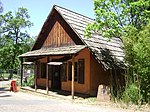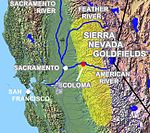Plymouth, California
1853 establishments in CaliforniaCities in Amador County, CaliforniaIncorporated cities and towns in CaliforniaMining communities of the California Gold RushPopulated places established in 1853 ... and 1 more
Use mdy dates from July 2023

Plymouth (formerly, Puckerville, Pokerville, and Poker Camp) is a city in Amador County, California, United States. The population was 1,005 at the 2010 census. The town was originally named Pokerville, when it was settled during the time of the gold rush. Plymouth is commonly now known as a "Gateway to Shenandoah Valley", a popular wine-producing region in the Sierra foothills. The Ione Band of Miwok Indians, a federally recognized tribe of Miwok people, is headquartered in Plymouth.
Excerpt from the Wikipedia article Plymouth, California (License: CC BY-SA 3.0, Authors, Images).Plymouth, California
CA 49,
Geographical coordinates (GPS) Address Nearby Places Show on map
Geographical coordinates (GPS)
| Latitude | Longitude |
|---|---|
| N 38.481944444444 ° | E -120.84472222222 ° |
Address
CA 49
California, United States
Open on Google Maps




